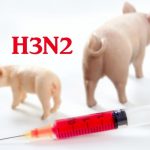 It’s now official. The swine flu virus (human influenza A H3N2) has undergone genetic changes during the latest flu season that began in September 2016.
It’s now official. The swine flu virus (human influenza A H3N2) has undergone genetic changes during the latest flu season that began in September 2016.
Data collected by the World Health Organisation (WHO) between September 2016 and February 2017 reveals that H3N2 underwent considerable genetic diversification. Swine flu picked up in Hyderabad during November 2016 and peaked during January and February this year. It claimed about a dozen deaths in Andhra Pradesh and Telangana.
During the period, the 2009 pandemic swine flu strain H1N1 was overshadowed by another strain, H3N2. But while H1N1 did not show any major genetic diversification, H3N2 did exhibit changes. In fact, three types of swine flu viruses have been in circulation in India since September 2016. Two A type and one B type virus affected people. H3N2 and B type viruses were present in India this flu season. The WHO in its latest Weekly Epidemiological Record (WER) points out that while type B influenza viruses showed sporadic infection, type A viruses were prevalent in large number of patients. The WER said there has been an increase in human flu activity in India and other countries as compared with that of the same period last year. The good news, however, is that all the three types of viruses continue to respond to existing drugs including Tamiflu. Of the over 4000 virus samples tested by WHO, only a handful of them showed resistance to the currently administered drugs.
“The large majority of A (H3N2) viruses collected from September 2016 to February 2017 belonged to the phylogenetic clade 3C.2a and subclade 3C.2a1. There has been considerable genetic diversification of the HA gene within this clade and subclade. A small number of clade 3C.3a viruses were also detected,” the WER said.
According to WHO, the antigenic characterisation of 3C.2a viruses continued to be technically difficult because many viruses did not agglutinate red blood cells in the absence or presence of the drug oseltamivir.
Source: The Times of India

















